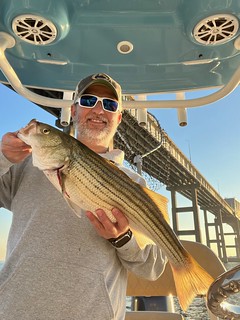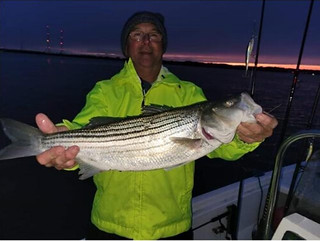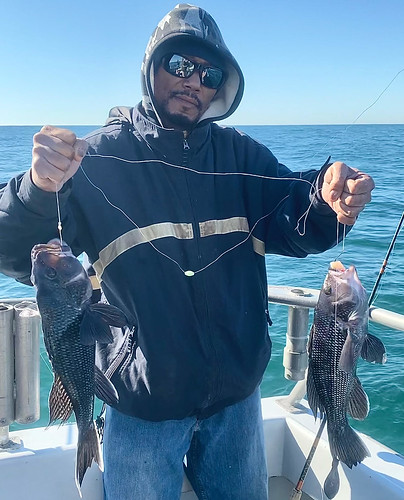Maryland Fishing Report – November 17
As we move through November there are plenty of excellent fishing opportunities to be had. The western mountain streams and rivers hold trout, smallmouth bass, and muskellunge. The small lakes and ponds that dot Maryland are providing a variety of fish that are feeding aggressively. The striped bass in the Chesapeake Bay are also feeling the urge to build up body stores. In the waters of the Atlantic, fishing for black sea bass does not get any better, with limit catches the norm.
Forecast Summary: November 17 – November 23:
Expect sunny, moderate, and windy weather through Thursday and then quickly turning cooler through the rest of the week. Surface waters and rivers continue to cool faster than the bottom waters. Bay surface water temperatures have dropped to the lower 50s. Baitfish have moved out of the rivers and search of the deeper, warmer waters with gamefish nearby. While there will be some breaking fish action, focus on the warmer, deeper, bottom waters such as river mouths, channel edges, underwater points, hard bottom, and drop-offs from the Bay Bridge south to the Virginia state line.
There is suitable oxygen to the bottom in all of Maryland’s Bay waters. Upper Bay waters down to Tilghman Island are running fresher than normal.
Expect normal flows for most Maryland rivers and streams except the Susquehanna River. There will be above average tidal currents all week due to the upcoming full moon on November 19.
Remnants of poor water clarity from recent rains on the main Bay are found from the Sassafras down to Tolchester. Expect poor water clarity for the Bush, Back, and upper Nanticoke rivers due to algal blooms. Expect good water clarity for other Maryland rivers and main Bay areas. To see the latest water clarity conditions, check Eyes on the Bay Satellite Maps.
For more detailed and up-to-date fishing conditions in your area of the Bay, check the Maryland DNR website for Click Before You Cast. Get regular updates on Maryland’s waters sent to your inbox with our Eyes on the Bay newsletter. Sign up online.

Chris Hottle caught this fine looking striped bass at the Key Bridge. Photo courtesy of Chris Hottle
The water releases at the Conowingo Dam have been on a 24-hour schedule, making for high water at the dam pool. Anglers are catching striped bass in the dam pool by casting topwater lures, swimshads and jerkbaits in the morning and evening hours. Most of the striped bass being caught are being released because they do not meet the 19-inch minimum.
Downriver at the mouth, there is a little striped bass action going on along the edges of the Susquehanna Flats in the morning and evening hours. The action is reported to be a fraction of what it was last month; water clarity seems to be the issue. The water is also getting colder, which can slow the action down and cause the striped bass to hold deeper. Jigging with soft plastics where suspended fish can be spotted is a viable option.
Water clarity is certainly not an issue with channel and blue catfish. Their sense of smell guides them to any nearby bait. Anglers are catching some impressive blue catfish in the tidal rivers of the upper Bay and if cleaned properly they offer excellent table fare. Almost any kind of fresh bait works well with cut menhaden, gizzard shad, and eel being at the top of the list.
Anglers are finding yellow perch in the tidal creeks and rivers of the upper Bay this week. Casting beetle spins is the most popular way to fish for them, and generally they are holding in the middle sections of the rivers. White perch have moved to the deeper channels near the mouths of the tidal rivers and are holding over hard bottom. They can also be found at times out in the Bay holding close to the bottom of various knolls and shoals. When the white perch are holding deep, bottom rigs baited with pieces of bloodworm or dropper rigs with small soft plastic jigs are the two most popular ways to fish for them.
A little farther down the Bay, there is good striped bass action to be found at the mouth of the Patapsco River and around the Key Bridge piers. Most are finding success by jigging around the bridge piers and along channel edges where suspended fish can be spotted on depth finders. The bait that striped bass are feeding on are usually juvenile menhaden that are leaving the tidal rivers. The mouths of the Magothy and Chester rivers are providing similar action. The Love Point rocks are always a draw for those wishing to cast jigs for striped bass.
Trolling is a great option in the upper Bay, which requires heavy inline weights and umbrella rigs to get down deep to where the fish are holding. Bucktails dressed with soft plastics or a single Drone spoon are the most popular trailers. A single bucktail or Drone spoon can also usually be pulled behind a planer without tripping it. Any channel edge where fish can be spotted on a depth finder holds the potential for striped bass at any time. A few of the recent hotspots are the Triple Buoys area, the Brewerton Channel, Swan Point, Love Point, the mouth of the Magothy River, the mouth of the Chester River, and the sewer pipe near the Bay Bridge.

Patrick McGrath caught this nice striped bass while jigging near the deep edge of Hackett’s Bar. Photo courtesy of Patrick McGrath
Water temperatures in the middle Bay are holding around 57 degrees this week and are falling rather quickly. Once they dip into the 40s, anglers are going to begin seeing the striped bass fishery slow down. On depth finders the fish will be spotted holding tight to the bottom in deeper waters, stacked like cordwood but unwilling to bite. Do not put off scheduling a few fishing trips, there is no better time to go than right now.
The Bay Bridge piers and rock piles are an excellent place to jig skirted soft plastic jigs. Drifting cut menhaden, small white perch, or if you’re really fortunate, spot near the pier bases is a great way to target striped bass holding there. The sewer pipe just north of the bridge on the eastern side is another structure worth checking out, whether you are jigging or trolling.
The channel edge in front of Hackett’s and on the eastern side of the bay the edge in front of the gum thickets are excellent places to either jig or troll. Striped bass are stacked along the channel edges there and on the eastern side south to Buoy 83 down to Sharps Island Light. Trolling has been a very popular way to fish and heavy inline weights and umbrella rigs are what most are using. Drone spoons or bucktails are the most common trailers being used. Planers are another option if fishing with a single small Drone spoon or bucktail.
Jigging is a popular option, especially when breaking fish can be spotted or suspended fish can be detected on a depth finder. Most of the breaking fish are small striped bass in the 17-inch range but larger fish can often be found underneath. Out in front of Poplar Island, Eastern Bay, the Miles River, the mouth of the Choptank, and the False Channel area are great places to look for breaking fish or concentrations of suspended striped bass. Small juvenile menhaden are the main item on the menu right now, as the bay anchovies have thinned out. The next daily special will be juvenile hickory shad in a couple of weeks, as they make their way out of the Choptank River and head for the ocean waters.
White perch are holding on deep water oyster bars near the mouth of Eastern Bay, the Choptank River, and the Severn River. It will take a watchful eye on a depth finder to spot them and a bottom rig baited with pieces of bloodworm or dropper rig to catch them. Fishing for a mix of channel and blue catfish is good in the tidal rivers of the region. The Choptank River is holding plenty of blue catfish in the Dover Bridge area. The west side of the old Dover Bridge has been turned into a fishing area with parking, however the east side is off limits for safety reasons.

Brian Bokulic caught this nice striped bass in Tangier Sound while casting a paddletail. Photo courtesy of Brian Bokulic
There are plenty of good fishing opportunities for striped bass, which are spread throughout the lower Bay from Tangier Sound to the lower Potomac River. Along the shorelines, casting paddletails and jerkbaits is a great way to target striped bass. On the eastern side of the Bay, speckled trout can be part of the mix, while the western shores hold mostly striped bass. Many do not quite meet the 19-inch minimum but there are plenty of larger striped bass to be found, and all are great fun on light tackle.
During the fall months, jigging is always a very popular way to target striped bass along channel edges or under breaking fish. The breaking fish are usually sub-legal striped bass and a few bluefish are still being reported in the Lower Bay. Working jigs under the surface fish is a great way to target larger striped bass lurking underneath. Popular spots include the edges of the shipping channel, the channels leading from the Nanticoke River, the HI Buoy area, the lower Potomac from Point Lookout to Smith Point, the lower Potomac from Piney Point to St. Georges Island, and the lower Patuxent River.
Trolling is a good option although it requires heavy tackle since heavy inline weights are needed to get umbrella rigs down deep to where the striped bass are holding. Most are using Drone spoons or bucktails dressed with a twistertail as trailers. The steep edge in the lower Potomac from St. Georges Island to Piney Point, the mouth of the Potomac from Point Lookout to Smith Point, and the eastern and western sides of the shipping channel in the Bay are all popular locations to troll for striped bass.
At last report, white perch were holding over oyster bottom near the mouth of the Patuxent River, the mouth of the St. Mary’s River, and also the north side of the Nanticoke River’s mouth. To no one’s surprise, the middle to upper Patuxent River and the middle of the Potomac River are loaded with blue catfish. If you catch a tagged blue catfish in the Patuxent River be sure to write down the tag number and release the catfish; they have transponder tags inside them and biologists are monitoring their movements. All other blue catfish should be harvested. The Nanticoke River near the mouth of the Marshyhope and the Sharpstown area is also holding a lot of blue catfish. They offer plenty of nonstop action and are a great addition to anyone’s freezer.

Brett Poffenberger had a great day on the upper Potomac, catching and releasing several muskies and smallmouth bass. Brett holds up this fine looking smallmouth bass before slipping it back into the river. Photo courtesy of Brett Poffenberger
Freshwater anglers are enjoying some wonderful fall weather and fishing conditions across Maryland. There are still plenty of trout to be found in the put-and-take areas, and the special management trout waters will be providing fun fishing opportunities all winter long. Many other species of sport fish are feeding aggressively in the cooler water conditions.
The upper Potomac River is running low and clear this week, and the smallmouth bass tend to be holding in the deeper holes of the river. A mix of tubes, grubs and small crankbaits are good choices to target them. This time of the year crayfish are one of the hottest items on the smallmouth bass menu as these little morsels try to find refuge in the deeper parts of the rivers as the grass thins out.
Deep Creek Lake is cooling down, and recreational boat traffic is mostly gone, leaving the lake clear for anglers to enjoy some peaceful fishing. There is good fishing for a mix of smallmouth bass, walleye, and yellow perch. Northern pike are providing plenty of action at the mouths of coves and crappie are schooled up near bridge piers.
Largemouth bass are on a feeding binge this week as cooling water temperatures signal it is time to bulk up body stores for the long winter months. Crayfish and small bait fish are hot items on the menu as these little critters leave the declining grass bed cover in the shallower areas and head for deeper cover. The largemouth bass are on the prowl for such activity, often in slightly deeper areas between the shallows and the deepest waters. Small crankbaits that resemble crayfish, soft plastic craw jigs, jerkbaits, grubs, and spinnerbaits are all good choices for baits.
Crappie are very active and tend to be schooled up near structure such as bridge piers, marina docks, and sunken brush. Small minnows or jigs under a slip bobber are a great way to target them. Casting small jigs and lures can also be very effective. The reservoirs of Baltimore County, the tidal Potomac near the Wilson Bridge and Fort Washington, and lakes and small ponds such as St. Mary’s Lake are great places to find crappie.
Surf anglers are soaking large baits of mullet and menhaden in hopes of catching some migrating striped bass close enough to take a bait. There were a few reports of striped bass around the 28-inch minimum size and a slot-sized red drum recently.
At the Ocean City Inlet, tautog are being caught around the jetty rocks and bridge piers on sand fleas. Most report that it is about a 50/50 split of tautog above and below the 16-inch minimum. Flounder are moving through the inlet on their way offshore, so they can be targeted with Gulp baits and traditional baits of squid strips and minnows. Anglers are having fun catching striped bass at the inlet and the bridges for Route 50 and Route 90, although most of these fish are undersized. The bay has been churned up due to strong winds but may clear up by the weekend; if it does, flounder fishing would be best in the channels leading towards the inlet.
Offshore fishing for black sea bass could hardly be better this week. Limit catches of fine-looking sea bass are common, and lately boat limits are just as common. A mix of triggerfish and bluefish can often be part of the mix. Some boats are now targeting tautog on some of the inshore wreck and reef sites now that waters are cooling and doing well.
“It takes several years of serious fishing before a man learns enough to go through a whole season with an unblemished record of physical and spiritual anguish.” — Ed Zern
Maryland Fishing Report is written and compiled by Keith Lockwood, fisheries biologist with the Maryland Department of Natural Resources.
Click Before You Cast is written by Tidewater Ecosystem Assessment Director Tom Parham.
This report is now available on your Amazon Echo device — just ask Alexa to “open Maryland Fishing Report.”

